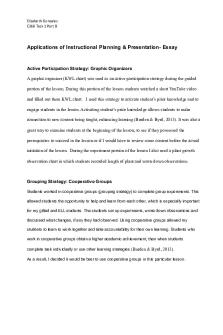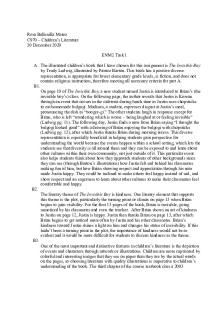KPina C100 Task 1 - Part of the PA for C100 PDF

| Title | KPina C100 Task 1 - Part of the PA for C100 |
|---|---|
| Author | Kevin Pina |
| Course | Introduction to Humanities |
| Institution | Western Governors University |
| Pages | 2 |
| File Size | 76.4 KB |
| File Type | |
| Total Downloads | 61 |
| Total Views | 139 |
Summary
Part of the PA for C100...
Description
Introduction to Humanities (C100) Task 1 Kevin Pina (Student ID: 000950688) Western Governors University
A1. Period Characterization In the aftermath of the Battle of Actium in 31 BC, the Roman consul to Augustus Caesar, Marcus Agrippa sought to build a building complex, one of which was The Pantheon. The original building however was destroyed by a large fire in the year 81 AD, and again in the year 110 A.D. All traces of the original building no longer existed. The ruling emperor at the time, Hadrian, ordered the reconstruction of the temple and had it completed between 118 – 128 AD. Hadrian chose to keep the original inscription, not only to honor the Consul member, but also show a symbolic between himself and the ancient empire (Ranogajec, 2015). During this era (known as the Classical Period), the Romans imitated Greek art and sculptures, but used concrete and marble in their works instead of the bronze that the Greeks used.
A2. Period Analysis The Pantheon, known as the “Temple of All the Gods” reflects the Classical Period in which it was built, characterized by its’ infusion of Roman and Grecian architecture, with the Romans applying advanced techniques to the Greek classical orders on the outer-portion of the building in addition to adding brick arches referred to as “relieving arches” (Craven, 2019). The interior of the Pantheon’s ceiling dome has a round opening in the center, which allows sunlight to stream in and illuminate the Parthenon rotunda. The Roman emperor Hadrian was quoted as saying “My intentions had been that this sanctuary of All Gods should reproduce the likeness of the terrestrial globe and of the stellar sphere…prayers would rise like smoke toward that void where we place the gods.” (Parker, 2009). This showcases the prevalence of Polytheism, as the Romans and other ancient civilizations worshipped multiple deities, with temples and other works of art such as this dedicated to them.
A3: Humanities Contribution Emperor Hadrian of Rome (117 AD – 138 AD) was known as the third of the Five Good emperors—the others being Nerva, Trajan, Antoninus Pius, and Marcus Aurelius. He is more famously known for his substantial construction projects throughout the Roman Empire, and Hadrian’s Wall in northern Britain. Historians often referred to Hadrian’s rule as the period in
which the Roman Empire was governed by absolute power under the guidance of wisdom and virtue. His love of Greece and Greek literature earned him the moniker ‘Greekling’ (Parker, 2009), which shows in the reconstruction of the Pantheon, the construction of Trajan’s Forum, in addition to other buildings, baths, and villas. He also established cities throughout the Balkan Peninsula, Egypt, Asia Minor, and Greece. His most notable contribution was Hadrian’s Wall, constructed in under six years by the legions stationed in Britain, as a representation of the might of the Roman Empire.
B: Sources Craven, J. (2019, July 30). Why You Should Know About the Pantheon in Rome. Retrieved from https://www.thoughtco.com/influencial-architecture-of-the-pantheon-177715 Parker, F. (2009, May 12). The Pantheon – Rome – 126 AD. Retrieved from https://www.monolithic.org/domes-more/the-pantheon-rome-126-ad Ranogajec, P. A. (2015, December 11). The Pantheon (Rome). Retrieved from https://smarthistory.org/the-pantheon/...
Similar Free PDFs

A Modest Proposal C100 rev 1
- 3 Pages

Project T6-1 - PA Task
- 10 Pages

Part1 - PA for the course
- 4 Pages

C726 PA ACP2 TASK 1 Notes
- 12 Pages

C768 Task 1 - Task 1 for C768
- 6 Pages

Task 1 - Complete Task 1 for C105
- 10 Pages

U.S. History Task4 - PA Task 4
- 8 Pages
Popular Institutions
- Tinajero National High School - Annex
- Politeknik Caltex Riau
- Yokohama City University
- SGT University
- University of Al-Qadisiyah
- Divine Word College of Vigan
- Techniek College Rotterdam
- Universidade de Santiago
- Universiti Teknologi MARA Cawangan Johor Kampus Pasir Gudang
- Poltekkes Kemenkes Yogyakarta
- Baguio City National High School
- Colegio san marcos
- preparatoria uno
- Centro de Bachillerato Tecnológico Industrial y de Servicios No. 107
- Dalian Maritime University
- Quang Trung Secondary School
- Colegio Tecnológico en Informática
- Corporación Regional de Educación Superior
- Grupo CEDVA
- Dar Al Uloom University
- Centro de Estudios Preuniversitarios de la Universidad Nacional de Ingeniería
- 上智大学
- Aakash International School, Nuna Majara
- San Felipe Neri Catholic School
- Kang Chiao International School - New Taipei City
- Misamis Occidental National High School
- Institución Educativa Escuela Normal Juan Ladrilleros
- Kolehiyo ng Pantukan
- Batanes State College
- Instituto Continental
- Sekolah Menengah Kejuruan Kesehatan Kaltara (Tarakan)
- Colegio de La Inmaculada Concepcion - Cebu








